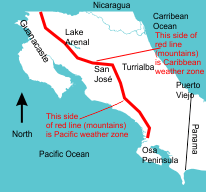Costa Rica Weather
 Only a low mountain range in the middle of a country 75 miles wide separates the Atlantic and Pacific Oceans. Because of these two oceans Costa Rica has surprisingly distinct weather -- and climate -- zones. The north and east zone is called the "Caribbean weather zone" (even though parts of that zone -- the Osa Peninsula --are on the Pacific coast) and the "Pacific weather zone" (which includes most of population - San José and the Central Valley).
Only a low mountain range in the middle of a country 75 miles wide separates the Atlantic and Pacific Oceans. Because of these two oceans Costa Rica has surprisingly distinct weather -- and climate -- zones. The north and east zone is called the "Caribbean weather zone" (even though parts of that zone -- the Osa Peninsula --are on the Pacific coast) and the "Pacific weather zone" (which includes most of population - San José and the Central Valley).
The Pacific Weather Zone
The Pacific zone has a very distinct dry season (mid December thru early April) and wet season (July thru November). During the dry season it's clear skies and hot -- daily temperatures on the beaches regularly reach 90°F (32°C), usually windy, and intense sunshine. March and April are the hottest months. San José is spared the highest temperatures because elevation (3800 ft or 1100 meters MSL) and spillover cooler air from the Caribbean zone nearby (the Continental Divide is between San José and Volare, 26 miles away).
Costa Rica's north and central Pacific coasts are similar to southern California weather (minus fire storms). Pacific ocean storms produce really big rains, with roads closed and knocking out power and downing big trees. The mountain slopes facing the Pacific have stunted trees (the rainforest giants don't survive well in dry season or wind) and are covered in short dry grasses ("chapparal"). North Pacific area (Guanacaste) is the driest and windiest part of Costa Rica, and the area crops (melons, mangoes, rice) rely heavily on irrigation. The irrigation water comes from the Caribbean Zone, from rivers diverted to Lake Arenal which then pass into Guanacaste.
The Pacific weather zone is home to popular beach destinations - Jaco, Tamarindo and the Nicoya and Guanacaste coastline down to Manuel Antonio.
Months not in wet or dry season are unpredictable... or actually, very predictable if you understand the effects of "El Niño" or "La Niña", weather phenomena involving ocean surface temperatures which affect the whole world's rain patterns.
Caribbean Weather Zone
The Caribbean Weather Zone is overall more mild, both in temperatures (rarely reaches 88°F. / 31°C). Monthly variation in precipitation is remarkably little. As a result the Caribbean weather zone is always lush, always green, so is home to big rivers (like the Pacuare), rain forest and cloud forests (high altitude rain forest with a completely distinct set of plants and animals). The mountain slopes are covered in giant rainforest trees. Low and soft clouds form usually in mid morning and protect crops and people from intense sunshine (and produce dramatic sunsets). The Caribbean weather zone is the breadbasket of Costa Rica - vegetables, dairy, sugar, meats - as well as tourism centers like La Fortuna (Arenal Volcano), Tortuguero, Turrialba, Osa Peninsula. The Caribbean beaches are softer, but not as developed for tourism as on the Pacific.
Dairy and Coffee are high altitude products and grow in both the Caribbean and Pacific weather zones. Sugar cane, banana and pineapple are lowland Caribbean weather crops, while melons are irrigated crops from the Pacific weather zone.
TEMPORALS are storms that arrive and stay in an area for 3 to 5 days, usually affecting the entire country. There are no trade winds this close to the equator, so nothing pushes weather along. Temporals happen any time of the year, in all parts of Costa Rica, unpredictably, so there is no "temporal" season you can avoid.
"Here, Hurricanes Hardly Ever Happen" is true for Costa Rica. We are a small strip of land (at our narrowest point we are only 75 miles from Atlantic to Pacific coasts) and a central mountain range stops storms from either direction. More important, we are entirely SOUTH of Colombia and Venezuela, tucked protectively in a cozy corner of the Caribbean Sea, and hurricanes would have to work awfully hard to navigate this far south and against a lot of east-moving currents to get to us. That's not saying we'll stay this protected as the oceans heat up -- or a really strong El Niņo turns our weather topsy-turvy.
